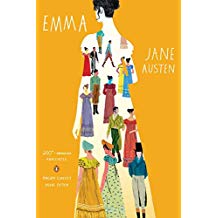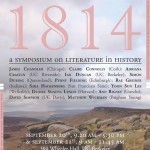by Trisha Urmi Banerjee
The essay begins:
 It is at least ironic that the characters and narration of Jane Austen’s Emma articulate excessively their preference for verbal and temporal economy. Clever Emma, who admires Mr. Martin’s proposal letter to Harriet for being “strong and concise; not diffuse,” observes later that charades “in general cannot be too short.” And at the end of dinner at Randalls, “while the others were variously urging and recommending, Mr. Knightley and Emma settled it in a few brief sentences” (122). It might surprise us that at the novel’s turning point, “a few minutes were sufficient for making [Emma] acquainted with her heart” (382), were it not the case that by this time, we have already heard the phrase “half a minute” ten times.
It is at least ironic that the characters and narration of Jane Austen’s Emma articulate excessively their preference for verbal and temporal economy. Clever Emma, who admires Mr. Martin’s proposal letter to Harriet for being “strong and concise; not diffuse,” observes later that charades “in general cannot be too short.” And at the end of dinner at Randalls, “while the others were variously urging and recommending, Mr. Knightley and Emma settled it in a few brief sentences” (122). It might surprise us that at the novel’s turning point, “a few minutes were sufficient for making [Emma] acquainted with her heart” (382), were it not the case that by this time, we have already heard the phrase “half a minute” ten times.
Aversion to waste and surplus takes perhaps its most glaring form in the frequency of the expression “to throw away.” When it appears outside dialogue, the phrase is always either ironic or negated. Suspicious Emma thinks Jane’s “caution was thrown away,” but that discretion successfully conceals the secret engagement to Frank (158). And we know that Mr. Elton, who arrives at Mrs. Bates’s house “so hot and tired that all [Mrs. Elton’s] wit seemed thrown away” on him, rather escapes than misses out on any so-called “wit” (429). The phrase’s early appearance teaches us that “danger” in Emma will be posed not by murder or intrigue but by waste, for “by Mr. Elton, a young man living alone without liking it, the elegancies and society of Mr. Woodhouse’s drawing room . . . were in no danger of being thrown away” (21). Incessantly, as if anxiously, the narration provides confirmations of safety from such danger: “The anxious cares, the incessant attentions of Mrs. Weston were not thrown away” at the Crown Ball where Mr. Knightley’s dancing “was not thrown away on Harriet” (306, 307).
The threats of waste here arrive in packages that announce the emptiness of their contents, assuring us that we can throw them away. But the possibility of waste is less easily dismissed when it threatens human beings. “Oh! But, dear Miss Woodhouse! [Jane] is now in such retirement, such obscurity, so thrown away. Whatever advantages she may have enjoyed with the Campbells are so palpably at an end!” (263). Here in passive voice, “thrown away” leaves unspoken the truth to which Mrs. Elton alludes, but like every Austen reader, she knows that future “advantages” can await Jane only in the right marriage. Indeed, a person’s safety from being thrown away in Emma is always constituted by an appropriate submission to the conjugal imperative—“appropriate” meaning something particular to each spouse. When Mr. Elton leaves Highbury to find a wife and returns with Mrs. Augusta Elton, we learn that “the story told well: he had not thrown himself away” (170). If the story of Emma tells well, perhaps it too avoids waste—perhaps for it, as for the snubbed Harriet, “to know that [Mr. Elton] has not thrown himself away, is such a comfort!” (252). Aversion to waste, especially within and surrounding the dominating context of marriage, would supersede or at least equal aversion to anything else.
Like the marriages that occur over the course of the novel, the parts of this argument number four. Part 1 applies the methodology of quantitative economics to model the dynamic between waste aversion and marriage in Emma, illustrating how its ending is a demonstrable utilitarian ideal. This illustration undergirds part 2, which argues that Emma advances the moral philosophy underlying the capitalist outlook that classical political economy began to theorize in the years leading up to the novel’s publication. Part 3 reveals the entwinement of political economy with economy of language, explaining how the novel’s concision works in tandem with its verbosity to iterate qualities of the free market that are in tension with the standards of maximum utility highlighted by the model. Whereas parts 2 and 3 rely primarily on the model’s conclusions, part 4 considers the model’s form, using it to understand the relation between the temporality and referentiality of the novel’s discourse.
The novel suggests several economies and numerous exchanges and congruities among them. There is first the capitalist economy as understood in the political economic theory that, as part 2 argues, informs the novel’s moral philosophy—a region’s system of producing and consuming goods and services. That economy has both a homologue and an analogue within the novel. The homologue is a conjugal economy that is composed of putatively rational actors seeking to maximize marital satisfaction. The analogue is a verbal economy involving the allocation of lexical efficiencies and inefficiencies (concision and diffusion). The nexus among these three economies is “economy” without an article: waste aversion, the result of economizing or being economical. Within both the homologue and the analogue of the economy—each one an economy—arise instances of economy. And, as parts 2 and 3 elucidate, it is the very nature of these instances that enables each economy not only to act as a parallel of the other and of the capitalist economy but also to iterate and advance capitalism’s dynamics and moral philosophy. Finally, underlying the entirety of the novel’s discourse and significantly modulating its free-market argument is a particular management of narrative speeds—what part 4 refers to as a temporal economy.
The very singularities of Emma that allow the perception of these economies also render it the quintessence of interrelations among economies and economics throughout Austen’s oeuvre. What emerges is a distinct and comprehensive account of Austen’s relation to contemporaneous economic theory (a relation much debated and theorized), of economy in her verbal and narrative style (much presumed and relatively little theorized), and of the correspondences between these two phenomena. Some of Emma’s singularities also help to delineate the entwinement of capitalist values with formal characteristics of the novelistic form generally. Likewise, the application of economic methodology to understanding Austenian economy evinces the potential of quantitative modeling to illuminate the forms and philosophies of literary texts. Continue reading …
By proposing a quantitative game-theory model of the marriage plot in Jane Austen’s Emma, Trisha Banerjee demonstrates that free-market moral philosophy underwrites Austen’s representation of matrimony and key formal elements of her writing—particularly, matters of verbal profusion. Her famed stylistic “economy” is revealed to be structured by the emerging capitalist economy that Adam Smith theorized in The Wealth of Nations. Establishing the correspondences among several kinds of economy, the essay unites economic and formal approaches to Austen’s work.
 TRISHA URMI BANERJEE recently received her PhD in English from Harvard University. Her current book project theorizes the relation between the dorsal surface of the human body and fundamental narrative structures.
TRISHA URMI BANERJEE recently received her PhD in English from Harvard University. Her current book project theorizes the relation between the dorsal surface of the human body and fundamental narrative structures.
 Of the essay, Banerjee herself writes: “By proposing a quantitative game-theory model of the marriage plot in Jane Austen’s Emma, the essay demonstrates that free-market moral philosophy underwrites Austen’s representation of matrimony and key formal elements of her writing—particularly, matters of verbal profusion. Her famed stylistic ‘economy’ is revealed to be structured by the emerging capitalist economy that Adam Smith theorized in The Wealth of Nations. Establishing the correspondences among several kinds of economy, the essay unites economic and formal approaches to Austen’s work.”
Of the essay, Banerjee herself writes: “By proposing a quantitative game-theory model of the marriage plot in Jane Austen’s Emma, the essay demonstrates that free-market moral philosophy underwrites Austen’s representation of matrimony and key formal elements of her writing—particularly, matters of verbal profusion. Her famed stylistic ‘economy’ is revealed to be structured by the emerging capitalist economy that Adam Smith theorized in The Wealth of Nations. Establishing the correspondences among several kinds of economy, the essay unites economic and formal approaches to Austen’s work.” TRISHA URMI BANERJEE received her PhD in English from Harvard University and is now based in Paris. “Austen’s Equilibrium” derives from her second book project, which uses economic modeling and theory to understand the “economics” of narrative language and structure.
TRISHA URMI BANERJEE received her PhD in English from Harvard University and is now based in Paris. “Austen’s Equilibrium” derives from her second book project, which uses economic modeling and theory to understand the “economics” of narrative language and structure.
 It is at least ironic that the characters and narration of Jane Austen’s Emma articulate excessively their preference for verbal and temporal economy. Clever Emma, who admires Mr. Martin’s proposal letter to Harriet for being “strong and concise; not diffuse,” observes later that charades “in general cannot be too short.” And at the end of dinner at Randalls, “while the others were variously urging and recommending, Mr. Knightley and Emma settled it in a few brief sentences” (122). It might surprise us that at the novel’s turning point, “a few minutes were sufficient for making [Emma] acquainted with her heart” (382), were it not the case that by this time, we have already heard the phrase “half a minute” ten times.
It is at least ironic that the characters and narration of Jane Austen’s Emma articulate excessively their preference for verbal and temporal economy. Clever Emma, who admires Mr. Martin’s proposal letter to Harriet for being “strong and concise; not diffuse,” observes later that charades “in general cannot be too short.” And at the end of dinner at Randalls, “while the others were variously urging and recommending, Mr. Knightley and Emma settled it in a few brief sentences” (122). It might surprise us that at the novel’s turning point, “a few minutes were sufficient for making [Emma] acquainted with her heart” (382), were it not the case that by this time, we have already heard the phrase “half a minute” ten times. TRISHA URMI BANERJEE
TRISHA URMI BANERJEE